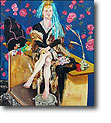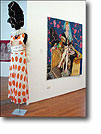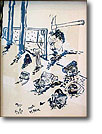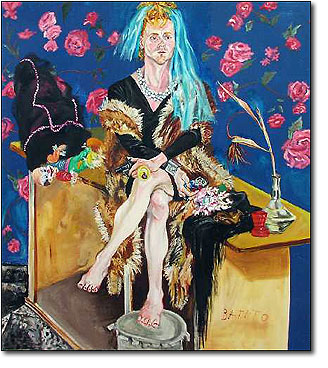Fundacion Proa ,
Nov 01, 2003 - Feb 04, 2004
Buenos Aires , Argentina
Argentine art in Proa
by Viviana Usubiaga
In December 2003, Argentina celebrated the twentieth anniversary of her return to democracy following the most inhumane dictatorship of her history (1976-1983). Spurred by this commemoration, the multidisciplinary exhibition Escenas de los ’80 (Scenes from the 80's), planned by the curator Ana María Battistozzi and carried out at the Fundación Proa (November 2003 to February 2004), brought together a group of pictorial and photographic works, documentation and graphic material on the aesthetic expressions produced during the first years of the decade. The showcase includes the plastic arts, represented by the works of Diana Aisenberg, José Garófalo, Ana Eckell, Duilio Pierri, Alfredo Prior, Martín Reyna, Juan José Cambre, Guillermo Kuitca, Guillermo Conte, Rafael Bueno, Marcia Schvartz, Luis Frangella, Alejandro Kuropatwa, Facundo de Zuviría, Majo Okner and Felipe Pino; photojournalism, music and communication media from the exciting port scene during the so-called democratic transition period. The proposal put forward by the curator can be interpreted as a response to other exhibitions on the artistic production of the 80s, which exclude one of the most relevant phenomena of the Buenos Aires cultural field: the underground culture. This attempt to portray the erasing of the limits of expressive language during the longed-for exit of the military dictatorship was presented as a tour through the varying scenes of the moment when aesthetic action was combined with the clamor for human rights; when fine arts were entangled with the theater, rock with illustrated publications, and literature with political caricature. An introductory hall, assembled under the guidance of researcher Roberto Amigo, displayed the historical context by means of a strict selection of photographs, magazines, newspapers and documents. The images of entry and exit from this space condensed the repeal of the decade’s political history: the scenes of rejoicing on December 10, 1983 - the day on which the new President Raúl Alfonsín took over- and the cover page of the newspaper announcing the amnesty granted to the military junta, promulgated by the presidency of Carlos Menem in 1989. Between one and the other, various friezes of images and texts narrated the principal events which mobilized the Argentine civil population: the Falklands War, the visit of the Pope, the proselytizing campaigns, the demonstrations by civil rights groups. Outstanding was the performance of the groups of artists’ communities such as G.A.S.T.A.R. (Group of Socialist Artists for the Transformation of Revolutionary Art) and C.A.PA.TA.CO. (Community of Common Rate Participative Art), together with the Mothers of the Plaza de Mayo, in the marches of resistence. Within these activities several aesthetic-political actions took place such as the so-called Siluetazo, which consisted of a molding of the body outlines with paint, alluding to those who had disappeared under State terrorism and who even today make their presence felt by outlining their absence in public places.
|













